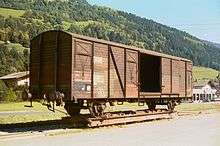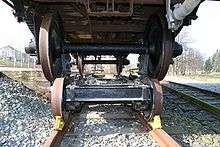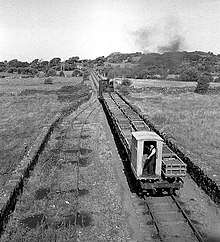Transporter wagon
A transporter wagon, in railway terminology, is a wagon (UIC) or railroad car (US) designed to carry other railway equipment. Normally, it is used to transport equipment of a different rail gauge. In most cases, a transporter wagon is a narrower gauge wagon for transporting a wider gauge equipment, allowing freight in a wider gauge wagons to reach destinations on the narrower gauge network without the expense and time of transshipment into a narrower gauge wagons.

This is an attempt to overcome one of the primary problems with differing gauge systems—gauge incompatibility. However, it means that the narrower gauge network must be built to a structure gauge large enough to accommodate the loading gauge of the wider gauge equipment, negating one of the cost advantages of a narrower gauge construction. Additionally, a large wider gauge wagon balanced on a narrower gauge transporter wagon is not very stable, and is generally restricted to low speeds of 15 mph (24.1 km/h) or so.
Transporter wagons have seen varying popularity. They were quite common in Germany (where they are called Rollwagen), Austria, Switzerland (here called Rollschemel in German and trucs transporteurs in French) and Sweden.
Transporter wagons were uncommon in North America, where the practice of exchanging trucks was more common, as was at one time the case on CN's Newfoundland Railway at Port aux Basques. They were used on the Paw Paw Railroad of Paw Paw, Michigan for a short time, and on a short stretch of track of the defunct Bradford, Bordell and Kinzua Railroad by lumberman Elisha Kent Kane. They were used in the United Kingdom on the Leek and Manifold Valley Light Railway.
Transporter flatcar
Transporter wagons were used extensively for a great many years in Germany, Austria (gauge 760 mm (2 ft 5 15⁄16 in)), Switzerland (1,000 mm (3 ft 3 3⁄8 in) Brünigbahn) and Sweden (gauges 802 mm (2 ft 7 9⁄16 in), 891 mm (2 ft 11 3⁄32 in), and 1,067 mm (3 ft 6 in)). This was a boon especially to exchange traffic on the extensive Swedish 891 mm network, which once comprised almost 2,000 km (1,243 mi) - in fact a number of local country areas in southern Sweden had nearly no 1,435 mm (4 ft 8 1⁄2 in) (standard gauge) lines at all, just narrow gauge ones. On the other hand, Rollböcke were not much used there.
An interesting development of the original transporter wagon concept (with bar couplers between each wagon) was that the bar couplers were discarded in favour of connecting all standard gauge wagons directly with each other by means of their ordinary buffing and draft gear. This was tried for a few years in Sweden just before the last narrow gauge freight lines were closed in the 1980s.
Special adaptors could be employed to couple a set of transporter wagons onto the end of an "ordinary" narrow gauge freight train. Continuous braking was no problem, either, as the train air line could be incorporated into the bar couplers, too.
Judging from early literature, the transporter wagon idea came about in Germany sometime around 1880 or 1890 (where in fact, later, Rollböcke were used a lot more than transporters). Transporter wagons with the unique Heberlein type friction brake system were in daily use in the old GDR (East Germany) well into the late 1980s.
In Britain, they were introduced to the Leek and Manifold Valley Light Railway in 1904 by Everard Calthrop, who also introduced them to the Barsi Light Railway in India of 1897. They carried the bulk of the freight traffic on the Leek and Manifold Valley.
Transporter wagons are widely used to get rolling stock including locomotives from gauge-isolated branch lines to main maintenance centres. The South Australia Railways had its "Crocodile" wagon for this purpose.[1]
Crocodile wagons
The South Australian and Victorian Railways used broad gauge transporter wagons to carry narrow gauge wagons including locomotives to workshops and other isolated narrow gauge sections. In South Australia, these were called crocodile wagons. There does not appear to have been any attempt to operate train-loads of crocodile wagons to diminish the disadvantages of the break of gauge.
A key dimension is whether the narrow gauge wheels fit between the broad gauge wheels, or whether the narrow gauge wheels have to travel on top of the broad gauge wheels.
The GWR also had crocodile waggons, which may be where the name in Australia came from. One of these is now in the Didcot Railway Centre[2]
Train on Train
"Train on Train" is an experimental concept for hauling narrow-gauge container wagons on standard-gauge Shinkansen tracks through the Seikan Tunnel in Japan.
Transporter train
During an intermediate phase of the conversion of the Port Pirie to Marree railway from a narrower gauge 1,067 mm (3 ft 6 in) to a standard gauge, train lengths of standard gauge flat wagons were fitted with narrow gauge rails, to allow a narrow gauge coal trains to by pass the difficult Flinders Ranges then affected by washaways.
The rails on the lower wagons were continuous, so that the upper train was moved on and off in one piece. Photo.[3]
The narrower gauge air brakes were connected to the standard gauge train's air brakes, to allow some flexing around curves. The narrower gauge train was also coupled to a buffer stop at one end of the standard gauge train.[4] A short ramp was installed to raise the narrow gauge trains about a metre onto the deck of the standard gauge train. There were no tight overbridges (overpasses) or tunnels to restrict operation of these double deck trains.
The standard gauge track was in this instance brand new and of a heavier standard with gentler curves and gradients than the narrow gauge track it replaced, so it is not clear whether a narrow gauge train could have transported a standard gauge train in reverse. It is noted that with a Weltrol well wagon, the load has to be lifted on and off by a crane one at a time, which is much slower.
With the transporter train, the loading gauge of the narrow gauge train under tunnels and overbridges needs to be about a metre taller than would otherwise be the case to allow for the height of the floor of the flat waggons and the rails thereupon.
The transporter train operated for about a year until the new standard gauge line to Leigh Creek was completed. The maximum speed of the piggyback train is unclear.
Transporter trailer

Also common on German and eastern European narrower gauge are transporter trailers, which are small-wheeled full trailers that fit beneath each pair of the wagon's wheels or each bogie of the car and are hauled by a drawbar. These are Rollböcke in German. Some times one long small-wheeled full trailer carries the entire rail car.
Road Transporter Trains
Transporter Trains are also used to carry road vehicles such as cars, lorries and buses through long rail tunnels. For long distance freight transport, trucks with trailers or semi-trailers (without tractor) are loaded on specialized rail vehicles. See articles about
See also

- East African Railway Master Plan
- Leek and Manifold Valley Light Railway 1904 used a Rollbock like wagon.
- Keith Smith (engineer) - devised transporting vehicles by the trainload in Australia the 1950s
- Weltrol - a standard gauge well wagon for carrying narrow gauge rolling stock ; built 1960[5]
- Padarn Railway
- Piggyback (transportation)
References
- A history of the South Australia Railways. Vol 1: The early years. p. 214.
- Baxter, Nick (16 April 2010). "GWR 41934 'Crocodile F' Bogie Well Wagon". Flickr. Retrieved 2 February 2013.
- Harding, Eric (1958). Uniform Railway Gauge. Lothian Publishing. p. 14.
- Smith, Keith A. Tales from a Railway Odyssey. p. 114.
- The Railway Magazine. July 2011. p. 89. Missing or empty
|title=(help)
- Hilton, George W. (1990). American Narrow Gauge Railroads. Stanford University Press. ISBN 0-8047-2369-9.
External links
| Wikimedia Commons has media related to Transporter trucks. |